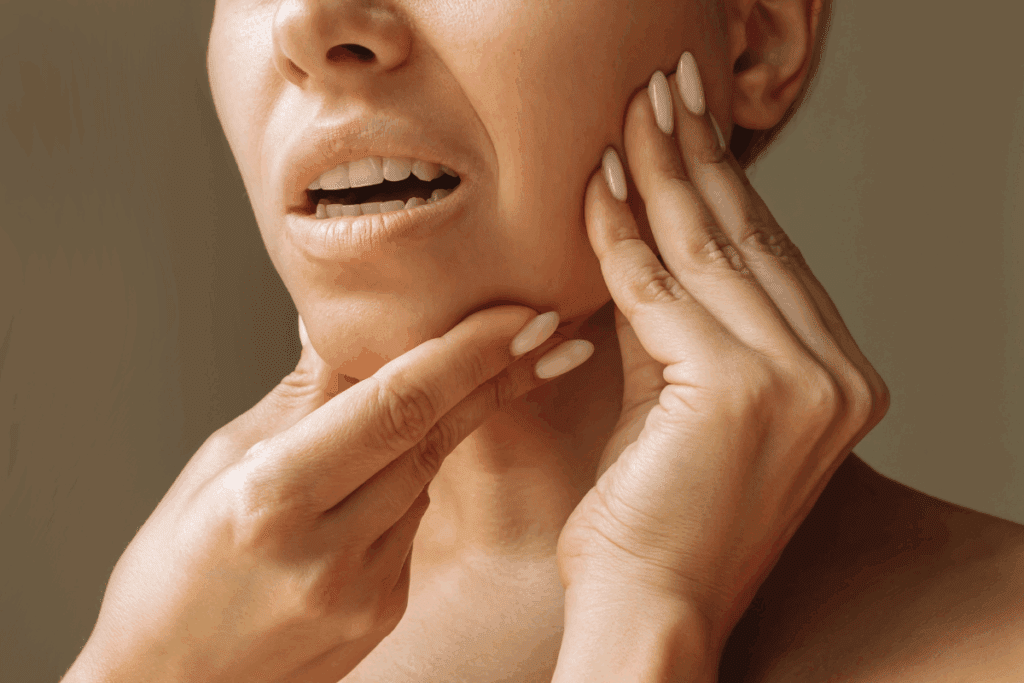Last Updated on November 20, 2025 by Hozen

Feeling pain in your jaw and throat at the same time can be confusing and uncomfortable. Many people face this issue, and it’s important to know why it happens.Why do I have jaw and throat pain at the same time? A guide to the most common causes, including infection and TMD.
The jaw and throat are closely linked, both in structure and function. Problems in one can often affect the other. This leads to a complex mix of pain and discomfort.
The temporomandibular joint (TMJ) is key, connecting the jaw to the skull. When this joint is not working right, it can cause pain in both the jaw and throat. The trigeminal nerve, which handles face sensations, plays a big role in sending pain signals from the jaw and throat to the brain.
It’s important to understand how the jaw and throat are connected. This knowledge helps doctors diagnose and treat pain in these areas better. By knowing about shared nerve pathways and referred pain, doctors can offer more effective treatments for jaw and throat pain.
To grasp jaw and throat pain, we need a detailed look. We’ll explore causes, symptoms, and treatments. This will help you understand your health better.
Many things can cause jaw and throat pain at the same time. This includes TMJ disorders, throat infections, and dental issues.
TMJ disorders can lead to pain in the jaw, face, and nearby areas. You might hear clicking or popping sounds when you open or close your mouth.
Throat infections, like strep throat, can hurt your throat and cause fever. You might also have swollen lymph nodes.
Dental issues, like tooth decay or gum disease, can also cause jaw and throat pain.
If you have ongoing or severe jaw and throat pain, you should see a doctor.

It’s important to know about TMJ disorders to treat jaw and throat pain. The temporomandibular joint (TMJ) links the jawbone to the skull. It’s key for chewing, speaking, and swallowing.
TMJ disorders show in many ways, like:
These symptoms can really affect your daily life and happiness.
The link between TMJ disorders and throat pain is complex. The TMJ is near nerves that can send pain to the throat. When the TMJ is inflamed or irritated, it can cause:
This pain can be mistaken for a throat infection or other issues. A detailed diagnosis is key.
Some factors can raise the risk of TMJ disorders, including:
Knowing these risk factors and symptoms helps find the right medical care for relief.

Yes, strep throat can cause jaw pain. This happens when the infection spreads to the tissues around the jaw. The bacteria from strep throat can cause inflammation in the jaw.
This inflammation leads to pain and stiffness in the jaw.
Many infections can cause jaw and throat pain. It’s important to know about these to get the right treatment.
Tonsillitis is when the tonsils get infected. It makes the throat very sore and can cause fever and swollen lymph nodes. If not treated, it can even harm the kidneys or lead to rheumatic fever.
A peritonsillar abscess is a pocket of pus behind the tonsils. It causes a lot of throat pain, makes swallowing hard, and raises the body temperature. You need to see a doctor right away to avoid worse problems.
Viral infections, like mononucleosis, can also hurt the jaw and throat. They make lymph nodes swell, cause fever, and make you feel very tired.
If you have ongoing or severe jaw and throat pain, you should see a doctor. They can find out what’s wrong and help you feel better. This way, you can avoid more serious issues.
| Infection | Symptoms | Treatment |
| Tonsillitis | Sore throat, fever, swollen tonsils | Antibiotics, pain management |
| Peritonsillar Abscess | Severe throat pain, difficulty swallowing, fever | Antibiotics, drainage of abscess |
Referred pain is a complex phenomenon that can show up in different ways, like in the face and neck. It’s important to understand what causes and how it works. This knowledge helps doctors give better diagnoses and treatments.
By knowing the patterns of referred pain, doctors can make more accurate diagnoses. They can then create treatment plans that really help patients feel better.
Figuring out jaw and throat pain takes a few steps. First, doctors look at your medical history. Then, they do a physical exam. Sometimes, they use imaging and lab tests too. This helps find the real cause of your pain.
Your doctor will ask you lots of questions at first. They want to know about your pain. They might ask:
It’s important to answer these questions accurately and thoroughly. This helps your doctor make a correct diagnosis.
A detailed physical exam is key. Your doctor will check your jaw, throat, and nearby areas. They look for swelling, tenderness, or other issues. They might also check how well your jaw moves and if it clicks or locks.
Sometimes, imaging tests like X-rays or MRI scans are needed. They help see inside your jaw and throat. Blood tests or throat cultures might also be done. These check for infections or other problems.
If your doctor thinks you might have a specific issue, like TMJ disorder or a throat infection, they might send you to a specialist. This could be a dentist, an ENT specialist, or another expert. They have more knowledge in that area.
When dealing with jaw and throat pain, a mix of treatments works best. This might include medicines, physical therapy, and changes in how you live.
For pain and swelling, you can try over-the-counter drugs like acetaminophen or ibuprofen. If it’s a bacterial infection, your doctor might give you antibiotics.
A physical therapist can help loosen up your jaw and throat. They use exercises and stretches to:
* Improve jaw movement
* Strengthen throat muscles
* Relax facial muscles
Changing your lifestyle can also help with jaw and throat pain. This includes:
* Keeping your mouth clean to avoid infections
* Eating soft foods
* Reducing stress with meditation or deep breathing
By using these methods, you can better manage your pain. This will improve your life quality.
Jaw and throat pain can really hurt. Luckily, there are home remedies that can help.
Using a warm or cold pack on the sore spot can ease the pain. A warm pack relaxes muscles. A cold pack helps reduce swelling.
Doing gentle jaw exercises can help. Start with small movements and slowly move more.
Adding these simple steps to your day can help you feel better.
Knowing how to handle jaw and throat pain is key to staying healthy. If your pain doesn’t go away or gets worse, see a doctor. They can give you the right advice and treatment.
Jaw and throat pain can come from many sources, including TMJ disorders, throat infections, dental issues, and pain that spreads from nearby areas.
TMJ disorders can send pain to the throat because the nerves in the jaw and throat are closely connected.
Yes, strep throat is a bacterial infection that can cause both throat and jaw pain.
Doctors may perform a physical exam, review medical history, and order imaging tests like X-rays or MRIs.
Treatments include pain medications, physical therapy, dental care, and addressing any underlying infections.
Yes, stress can tighten jaw and neck muscles, leading to pain or worsening existing discomfort.
Maintain oral hygiene, avoid clenching or overusing the jaw, and manage stress effectively.
Common symptoms include a sore throat, difficulty swallowing, fever, and swollen glands.
Yes, issues like tooth decay, gum disease, and abscesses can cause jaw and throat pain.
A healthcare professional can determine the cause of pain, recommend appropriate treatments, and help manage symptoms.
Subscribe to our e-newsletter to stay informed about the latest innovations in the world of health and exclusive offers!